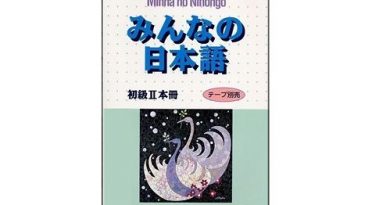Contents
Learn minna no nihongo lesson 33
6. Mondai
To do the “Mondai” section, you need “minna no nihongo” book and audios for listening
Exercise 1: Listen and answer questions
With this exercise, first you need to listen to the question and write down what you have listened and then answer the question according to your own understanding. You should not try to focus on clearly listening to each word of a sentence then missing the following sentences. You should listen it for the first time, answer the questions one by one, with the questions you can’t listen then listening to them the second time. After that, you can listen again and copy the words to improve your listening skill and remember words better. Finally, after listening and answering all questions, you can refer to the translation and the answer below.
Translation :
1. (1) に書いてある字はなんと読みますか。
ichi ni kai te aru ji ha nanto yomi masu ka.
How do you read the letter written in number (1) ?
2. 禁煙はどういう意味ですか。
kinen ha douiu imi desu ka.
What does “kinen” mean?
Answer :
1. 「みんな の日本語」 と 読みます。
“Minna no nihongo” to yomimasu
It is pronounced as “minna no nihongo”
2. たばこ を 吸うなと いう 意味です。
tabako wo suuna to iu imidesu.
It means “Don’t smoke”.
Exercise 2: Listen and choose true or false
With this exercise, the listeners will listen to the conversation, then there will be a key point about the problem that will be raised in the conversation. The listeners must choose whether the content is true or false according to what they has listened. If it is true, select 〇 (maru) and if it is false, choose ✖ (batsu). In this listening section, you should pay attention to the concluding sentence to see whether that sentence is given in a positive or negative form in order to avoid being “tricked” when listening.
1.
男: すみません。あれは 何と 読みますか。
Excuse me. How do you read that?
女: 「使用禁止」です。
It is pronounced as “shiyoukinshi”
男: どういう いみですか。
What does it mean?
女: 使うなという 意味です。
It means “Don’t use”
★ 使用禁止は 使っては いけないと いう 意味です。
★ Shiyoukinshi means that you mustn’t use it.
Answer:(〇)
2.
女: どうしたんですか
What happened?
男:コピー機が 働かないんです。
The copy machine is not working.
女: あ、ここに 「故障」と 書いてあります。
A, it says “Broken” here.
男: そうですか。
Is that so
★ コピー機は 今使えません。
★ Can not use the copy machine now.
Answer(〇)
3.
男: もしもし。田中さんですが、ミラーさんは いますか。
Hello. It’s Tanaka, is Mr. Miller there?
女: いま、出かけて いますが、3時ごろ 戻ると 言って いました。
He is going out now, he said that he would return around 3 o’clock.
男: じゃ、3時ごろ また かけます。
Well, I will call again around 3 o’clock.
★ ミラーさんは 3時ごろ 戻るでしょう。
★ Mr. Miller will return around 3 o’clock
Answer(〇)
4.
女: グプタさんは いますか。
Is Mr. Guputa here?
男: いま ちょっと 席を 外して いますが。
He is currently away from his desk.
女: じゃ、すみませんが、グプタさんに パーティーは 駅の前の 「つるや」ですると 伝えて いただきませんか。
Well, excuse me, could you please tell Mr. Guputa that the party will be held at “tsuruya” in front of the station?
男: 「つるや」ですね。わかりました。
“Tsuruya”, right? I got it.
★ 女の人は グプタさんに パーティーの 場所を 伝えます。
★ The woman will tell Mr. Guputa about the party’s place
Answer(〇)
5.
男1: 頑張れ!山田。投げろ!
Hang in there! Yamada. Throw it!
男2: すみません。
I’m sorry…
男1: 大丈夫、大丈夫。次の試合で 頑張ろう!
All right, all right. Let’s do our best in the next match!
男2:はい、次の試合は きっと 勝ちます
Yes, we will surely win the next match
★ 山田君は 今の試合で 失敗しましたが、次の試合で がんばります。
★ Yamada failed the current match, but he will do his best in the next match.
Answer(〇)
Exercise 3: Give the command form and prohibition form of the verb
This exercise will help you review the command form and prohibition form. Before doing, you need to review the verbs and the groups of verbs to be able to give the true command and prohibition form of the verbs.
| 行きます | ||
| 急ぎます | ||
| 立ちます | ||
| 出します | ||
| 止めます | ||
| 忘れます | ||
| 来ます | ||
| 運転します |
Answer
| 行きます | 行け | 行くな |
| 急ぎます | 急げ | 急ぐな |
| 立ちます | 立て | 立つな |
| 出します | 出せ | 出すな |
| 止めます | 止めろ | 止めるな |
| 忘れます | 忘れろ | 忘れるな |
| 来ます | 来い | 来るな |
| 運転します | 運転しろ | 運転する何 |
Exercise 4: Read the following paragraph and answer the questions
(1) 昔 電話がない 人が 電報で 急ぐ 用事を つたえました。
(2) 昔 電報は 全部 かたかなで 書きました。
(3) 今 電報は 結婚式と 葬式の ときしか 使いません。
Translation and Answer
Telegram
In the old days, when there were not many telephones, people sent a telegram when having urgent business.
Because the telegram charges was expensive, people tried to write as short as possible. Moreover, they have to write all in katakana. For example “Hahakitokusugekaeru”. It means “Mother is feeling heavy sickness, come back soon”. But sometimes they don’t understand the meaning. May “Aisurusubanikoi” mean “I will be away from home tomorrow. Come in the evening” or “Come for caretaking tomorrow”?
Nowadays, people often use telegrams when they want to convey their wedding wishes or condolences when someone is dead. Furthermore, they can also use hiragana or kanji.
Question:
1. In the old days, the people who didn’t have telephone could convey an urgent business by a telegram. (〇)
2. In the old days, all telegrams were written in katakana.(〇)
3. Nowadays, telegrams are only used for weddings and funerals.(✖)
Above is instruction to Learn minna no nihongo lesson 33. See other lessons in category : learn Japanese with minna no nihongo or: Japanese for beginers.


